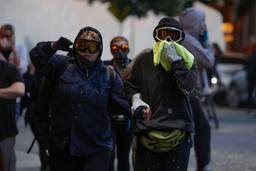U.S. Military Toxins: The Gift That Keeps on Killing
A tragic history of pollution continues in Iraq and Afghanistan.
Terry J. Allen

Hey, Iraq, don’t say we never gave you anything. In addition to hundreds of thousands dead and untold injured, the United States is leaving behind enough toxic waste sites to kill your rats.
“Open-air burn pits have operated widely at military sites in Iraq and Afghanistan,” the Department of Veterans Affairs notes on its website. On hundreds of camps and bases across the two countries, the U.S. military and its contractors incinerated toxic waste, including unexploded ordnance, plastics and Styrofoam, asbestos, formaldehyde, arsenic, pesticides and neurotoxins, medical waste (even amputated limbs), heavy metals and what the military refers to as “radioactive commodities.” The burns have released mutagens and carcinogens, including uranium and other isotopes, volatile organic compounds, hexachlorobenzene, and, that old favorite, dioxin (aka Agent Orange).
The military pooh-poohs the problem, despite a 2009 Pentagon document noting “an estimated 11 million pounds [5,000 tonnes] of hazardous waste” produced by American troops, the Times of London reported. In any case, it says, the waste isn’t all that toxic, and there is no hard evidence troops were harmed. Of course, one reason for that lack of evidence, reports the Institute of Medicine (which found 53 toxins in the air above the Balad air base alone), is that the Pentagon won’t or can’t document what it burned and buried, or where it did so.
The little media attention that has been paid to this massive pollution has dimly illuminated its potential impact on U.S. troops. Left in mephitic darkness are the contractors, often impoverished South Asians, who did the dirty work at the bases, as well as Iraqi civilians who live and farm nearby. The Times of London reported that “open acid canisters sit within easy reach of children, and discarded batteries lie close to irrigated farmland,” causing people to sicken and rats to die “next to soiled containers.”
The toxic air echoes with the Vietnam War’s Agent Orange fiasco. Victims of that war’s dioxin suffered for years before the United States took limited responsibility – but only for its troops, and not for the countries it poisoned.
The military’s history of pollution is long and largely unmitigated by legislation, treaties or lawsuits. It stretches around the world, from bases in the Philippines to Okinawa, Kuwait to Canada, and to numerous U.S. sites as well.
Once upon a time – before 9/11 turned conspiracy theories into a self-righteous boom industry – Area 51 was an amusing Mecca for a dedicated band of tinfoil-hat nutters who fantasized about alien anal probes and insisted that the government was hiding space aliens on a secret Air Force Base in the Nevada desert.
But a real and more nefarious plot was the military’s exploitation of lax regulation and worker confidentiality agreements to use Area 51 as a secret dumping/burning ground for the toxic waste shipped in from other bases.
As deaths mounted at Area 51, workers – and their widows – sued, producing evidence that the military had regularly filled football-field-sized trenches with 55-gallon drums of hazardous waste, doused them with jet fuel and set them ablaze. The lawsuit foundered on the shoals of “national security” secrecy. The military got away with murder.
Fast forward to U.S. military bases around the world that are similarly immune from effective regulation and reporting. GAO investigators charge that the military in Iraq burned prohibited substances and ignored “guidance” to monitor emissions and to analyze its waste stream.
Again, sick and dying vets, this time from Iraq and Afghanistan, are trying to trace their cancers and respiratory problems to the toxins of war. Again, the military refuses to release complete data, and claims the data show no harmful effects. Again, the assumption of culpability, and the clean-up efforts will come too little, too late.
A July article in the New England Journal of Medicine studied 80 soldiers disabled with constrictive bronchiolitis, “a very rare finding” in otherwise healthy, young non-smokers. Almost all the cases were traced to “inhalational exposures during service in Iraq and Afghanistan.” The journal lamented : “This group causes particular concern, since their potential toxic exposures are shared by most personnel who were deployed to Iraq and Afghanistan.”
And, oh, yes, by those left to endure the predictable consequences of expedient poisoning. You’re welcome, Iraq.









